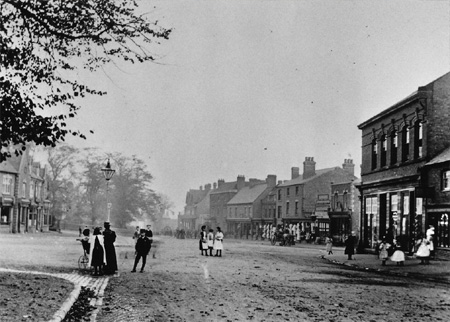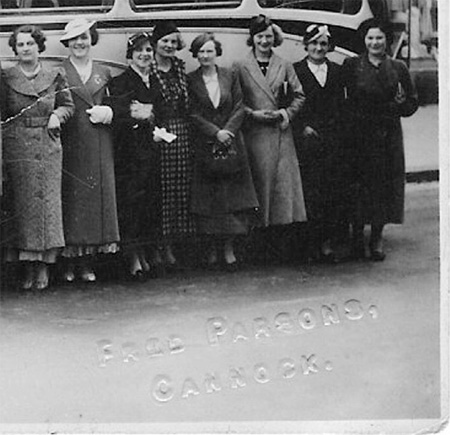A brief history of Cannock
The name Cannock may derive from the Celtic word
Gnoc or Cnoc, meaning high place. A settlement at
Cannock is mentioned in the Domesday Book.
Mediaeval Cannock
Cannock was once part of an extensive forest, which, in 1086,
became the royal hunting ground of William the Conqueror. In
1189 the manor of Cannock passed from the king to the Bishop
of Coventry and Lichfield. Then, in 1259, Cannock was granted
the right to hold a weekly market – an important step in
becoming a thriving trading community.

A fashionable spa town
During the 17th and 18th centuries, the quality of its water gave Cannock a reputation as a spa town, which attracted a number of wealthy families. We
can still glimpse some of their wealth in the houses around High Green, which was then the town centre.

Cannock town centre, looking south. This image probably dates from the early 1900s.
Image courtesy of the Museum of Cannock Chase
The development of the coal industry
As late as 1851, Cannock was described in White’s History
Gazeteer & Directory as a large and well built village. Soon after
this, the rapid growth of the coal industry brought major changes.
Large numbers of coal miners and their families began to move
into the area. New housing was built, and the town developed
and changed to cater for the needs of its increased population.
Bricks, tiles, iron and edge tools
Until well into the 20th century, the brick-making, tilemaking
and iron founding industries were among
those important to the Cannock area, as was the
manufacture of edge tools (tools such as chisels, that
have a cutting edge). Communities such as Wedges
Mills, Churchbridge and Bridgtown grew up south of
Cannock to house the edge tool workers. The two main
employers were Gilpin and Whitehouse, both among
the most prominent manufacturers in the country.

Image courtesy of the Museum of Cannock Chase
This row of three-storey terraced cottages was built around 1795 by the edge
tool manufacturer William Gilpin. One of the last rows of ‘back-to-back’
housing in the district, it was pulled down in the 1950s.
|
Roads, canals and railways
Cannock is linked by road to the nearby city of
Lichfield, and to the towns of Stafford and
Walsall. It is only a mile from the ancient Roman
road of Watling Street, better known today as
the A5. These roads helped Cannock’s trades and
industries to flourish. By 1818, stage coaches
travelling between London and Liverpool passed
through the town three times a week.
In later years, the development of the local
canal and railway networks meant that coal
from Cannock and the surrounding areas could
be transported all over the country.

The local road network as it was in 1800,
shown on a map of the Cannock Chase
Heritage Trail. The number of roads
converging on the town was crucial in Cannock’s development as a trading centre.
Devised by Ben Gammon based on originals
produced by Dr David Brown.
Cannock since the Second World War
During the 1950s and 60s, Cannock saw major redevelopment,
particularly in the areas south-west of the town.
Although many of the local industries have long since declined,
Cannock has continued to develop and grow. In the town centre,
the building of a new shopping centre was completed in 1996
and development of High Green Court began in 2002.

Image courtesy of the Museum of Cannock Chase
This photograph dates from about 1910-1920. On the right is the Crown Hotel.
On the left is the old market hall, built in 1869. They were situated in Market
Place, near to where you are standing. Both were demolished in the early
1960s to make way for a row of modern shops.
A new urban district
In 1877 Cannock was divided into
three wards – Cannock, Chadsmoor
and Hednesford. In 1894 the Urban
District of Cannock was formed and
in 1900 three new wards,
Bridgtown, Heath Hayes and
Littleworth, were added. In 1934
the hamlet of Hazel Slade and part
of Norton Canes were also
incorporated into the urban district.
In 1974 Rugeley and Brindley
Heath became part of the newly
formed administrative district of
Cannock Chase. |
The picture below is taken from a
postcard. Even though the postcard
was never written, it can give us
lots of clues to the past.
In 1935, when this branch of Woolworth’s
opened in Market Place, everything on
sale cost either threepence or sixpence
(1.25p or 2.5p).
On most counters there were shop
assistants who selected the goods for
customers and worked the tills. In 1972,
the shop converted to a self-service
system, with a checkout at the store exit.

Image courtesy of Ray Smith
The passengers are probably going on a day trip. A local beauty spot such as Seven Springs on Cannock Chase, or a seaside resort such as Blackpool or Llandudno, are likely destinations. |
This bus is one of two that were purchased new
by Mrs E.P. Homer of Stafford Road, Cannock, who
ran a coaching firm. Its number-plate is likely to
be either BRE 477 or ERE 602. The body of the
vehicle would have been made by Burlingham
Coachbuilders of Blackpool, on a Leyland chassis
made near Preston. In about 1940-42, Mrs
Homer’s coaching firm was taken over by Harper’s
of Heath Hayes.

Fred Parsons, Cannock is embossed at the
lower right of the postcard. Fred Parsons
was a Cannock photographer.
|







